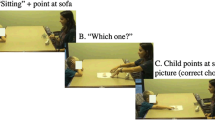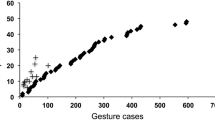Abstract
We studied how gesture use changes with culture, age and increased spoken language competence. A picture-naming task was presented to British (N = 80) and Finnish (N = 41) typically developing children aged 2–5 years. British children were found to gesture more than Finnish children and, in both cultures, gesture production decreased after the age of two. Two-year-olds used more deictic than iconic gestures than older children, and gestured more before the onset of speech, rather than simultaneously or after speech. The British 3- and 5-year-olds gestured significantly more when naming praxic (manipulable) items than non-praxic items. Our results support the view that gesture serves a communicative and intrapersonal function, and the relative function may change with age. Speech and language therapists and psychologists observe the development of children’s gestures and make predictions on the basis of their frequency and type. To prevent drawing erroneous conclusions about children’s linguistic development, it is important to understand developmental and cultural variations in gesture use.
Similar content being viewed by others
References
Allwood, J. (1999). Are there Swedish patterns of communication? In H. Tamura (Ed.), Cultural acceptance of CSCW in Japan & Nordic countries (pp. 90–120). Kyoto: Kyoto Institute of Technology. Retrieved from http://www.ling.gu.se/~jens/publications/docs076-100/087.pdf.
Bates E., Dick F. (2002) Language, gesture, and the developing brain. Developmental Psychobiology 40(3): 293–310
Bello A., Capirci O., Volterra V. (2004) Lexical production in children with Williams syndrome: Spontaneous use of gesture in a naming task. Neuropsychologia 42: 201–213
Blake J., Myszczyszyn D., Jokel A., Bebroglu N. (2008) Gestures accompanying speech in specifically language-impaired children and their timing with speech. First Language 28(2): 237–253
Capirci O., Volterra V. (2008) Gesture and speech—The emergence and development of a strong and changing partnership. Gesture 8(1): 22–44
Capone N. C. (2007) Tapping toddlers’ evolving semantic representation via gesture. Journal of Speech, Language, and Hearing Research 50(3): 732–745
Carbaugh D. A. (2005) Cultures in conversation. Lawrence Erlbaum Associates, Mahwah, NJ
Carbaugh D. A., Berry M., Nurmikari-Berry M. (2006) Coding personhood through cultural terms and practices. Silence and quietude as a Finnish “natural way of being”. Journal of Language and Social Psychology 25(3): 1–18
Corballis M. (2002) From hand to mouth: The origins of language. Princeton University Press, Princeton, NJ
Eriksson M., Berglund E. (1999) Swedish early communicative development inventories: Words and gestures. First Language 19(55): 55–90
Fenson L., Dale P., Reznick J., Bates E., Thal D., & Pethick S. (1994). Variability in early communicative development. Monographs of the Society of Research in Child Development. Serial No. 242, 59.
Gentilucci M., Dalla Volta R., Gianelli C. (2008) When the hands speak. Journal of Physiology-Paris 102(1–3): 21–30
German D. (1984) Diagnosis of word-finding disorders in children with learning disabilities. Journal of Learning Disabilities 17(6): 353–359
Goldin-Meadow S. (2003) Hearing gesture: How our hands help us think. Belknap Press, Cambridge
Goldin-Meadow S., Saltzman J. (2000) The cultural bounds of maternal accommodation: How Chinese and American mothers communicate with deaf and hearing children. Psychologial Science 11(4): 307–314
Iverson J. M., Braddock B. A. (2011) Gesture and motor skill in relation to language in children with language impairment. Journal of Speech, Language, and Hearing Research 54(1): 72–86
Iverson J. M., Capirci O., Longobardi E., Caselli M. C. (1999) Gesturing in mother–child interactions. Cognitive Development 14(1): 57–75
Iverson J. M., Capirci O., Volterra V., Goldin-Meadow S. (2008) Learning to talk in gesture-rich world: Early communication in Italian vs. American children. First Language 28(2): 164–181
Iverson J. M., Goldin-Meadow S. (1997) What’s communication got to do with it? Gesture in children blind from birth. Developmental Psychology 33(3): 453–467
Iverson J. M., Goldin-Meadow S. (2001) The resilience of gesture in talk: Gestures in blind speakers and listeners. Developmental Science 4(4): 416–422
Jakkula, K. (2002). Esineiden antaminen. Kehityksen peili ja kieltä ennakoiva sosiaalinen merkki 9-34 kuukauden iässä (Giving objects. A mirror of development and a social sign anticipating language acquisition of 9-34 months old children). Acta Universitatis Ouluensis, Series E, Scientiae Rerum Socialium 52. University of Oulu, Oulu, Finland. Retrieved from http://herkules.oulu.fi/isbn9514266536/isbn9514266536.pdf.
Karmiloff-Smith A. (1996) Beyond modularity: A developmental perspective on cognitive science. The MIT Press, Cambridge, MA
Kita S. (2009) Cross-cultural variation of speech-accompanying gesture: A review. Language and Cognitive Processes 24(2): 145–167
Laakso M., Helasvuo M.-L., Savinainen-Makkonen T. (2010a) Children’s early actions in learning language: A study of proto-words and pointing gestures in interaction between one-year-old child and parent. SKY Journal of Linguistics 23: 199–226
Laakso, M.-L., Eklund, K., & Poikkeus, A.-M. (2010b). Lapsen esikielellisen kommunikaation ja kielen ensikartoitus (Survey of the child’s preverbal communication and language). Jyväskylä: Niilo Mäki Instituutti.
Laakso M.-L., Poikkeus A.-M., Katajamäki J., Lyytinen P. (1999) Early intentional communication as a predictor of language development in young toddlers. First Language 19(56): 207–231
Levelt W. J. M. (1989) Speaking: From intention to articulation. The MIT Press, Cambridge
Levelt W. J. M., Roelofs A., Meyer A. S. (1989) A theory of lexical access in speech production. Behavioral and Brain Sciences 22(1): 1–38
Lock A., Young A., Service V., Chandler P. (1994) Some observations on the origins of the pointing gesture. In: Volterra V., Erting C. J. (eds) From gesture to language in hearing and deaf children. Gallaudet University Press, Washington, DC, pp 42–55
Mayberry R. I., Nicoladis E. (2000) Gesture reflects language development: Evidence from bilingual children. Current Directions in Psychological Science 9(6): 192–196
McCroskey J. C., Fayer J. M., Richmond V. P., Sallinen A., Barraclough R. A. (1996) A multi-cultural examination of the relationship between nonverbal immediacy and affective learning. Communication Quarterly 44(3): 297–307
Mäkisalo A. (1988) Suomalainen kommunikaatio ulkomaalaisen silmin (Finnish communication as seen by a foreigner). Opettaja 83(10): 20–21
Nicoladis E. (2002) Some gestures develop in conjunction with spoken language development and others don’t: Evidence from bilingual preschoolers. Journal of Nonverbal Behavior 26(4): 241–266
Nicoladis E., Pika S., Marentette P. (2009) Do French–English bilingual children gesture more than monolingual children?. Journal of Psycholinguistic Research 38(6): 573–585
Goldin-Meadow S., Goldin-Meadow S. (2009) When gesture speech combinations do and do not index linguistic change. Language and Cognitive Processes 24(2): 190–217
Ozyürek A., Kita S., Allen S., Brown A., Furman R., Ishizuka T. (2008) Development of cross-linguistic variation in speech and gesture: Motion events in English and Turkish. Developmental Psychology 44(4): 1040–1054
Pika S., Nicoladis E., Marentette P. (2006) A cross-cultural study on the use of gestures: Evidence for cross-linguistic transfer?. Bilingualism: Language and Cognition 9(3): 319–327
Pine K. J., Bird H., Kirk E. (2007a) The effects of prohibiting gestures on children’s lexical retrieval ability. Developmental Science 10(6): 747–754
Pine K. J., Gurney D. J., Fletcher B. C. (2010) The semantic specificity hypothesis: When gestures do not depend upon the presence of a listener. Journal of Nonverbal Behaviour 34(3): 169–178
Pine K. J., Lufkin N., Kirk E., Messer D. (2007b) A microgenetic analysis of the relationship between speech and gesture in children: Evidence for semantic and temporal asynchrony. Language and Cognitive Processes 22(2): 234–246
Pine K. J., Lufkin N., Messer D. J. (2004) More gestures than answers: Children learning about balance. Developmental Psychology 40(6): 1059–1067
Poutiainen, S. (2007). Finnish cultural discourses about mobile phone communication. Doctoral dissertation. University of Massachusetts Amherst, Department of Communication. Retrieved from http://www.helsinki.fi/puhetieteet/henkilokunta/poutiainen/dissertation.pdf.
Rauscher F. H., Krauss R. M., Chen Y. (1996) Gesture, speech, and lexical access: The role of lexical movements in speech production. Psychological Science 7(4): 226–231
Remes K. (1975) Artikulaatiotesti. Kuvakortisto puheenkehityksen ja äännevirheisyyden tutkimiseen ja tarkkailuun. Koulun Erityispalvelu, Helsinki
Rowe M. L., Özçalişkan S., Goldin-Meadow S. (2008) Learning words by hand: Gesture’s role in predicting vocabulary development. First Language 28(2): 182–199
Sajavaara, K., & Lehtonen, J. (1997). The silent Finn revisited. In A. Jaworski (Ed.), Silence. Interdisclipinary perspectives (pp. 263–283). Studies in Anthropological Linguistics, 10. Berlin: Mouton de Gruyter.
Sallinen-Kuparinen, A. (1986). Finnish communication reticence: Perceptions and self-reported behavior. Studia philologica Jyväskyläensia, 19. Jyväskylä (Finland): University of Jyväskylä.
Stefanini S., Caselli M. C., Volterra V. (2007) Spoken and gestural production in a naming task by young children with Down syndrome. Brain and Language 101(3): 208–221
Stefanini S., Bello A., Caselli M. C., Iverson J., Volterra V. (2009) Co-speech gestures in a naming task: Developmental data. Language and Cognitive Processes 24(2): 168–189
Thal D., Tobias S., Morrison D. (1991) Language and gestures in late talkers. A 1-year follow up. Journal of Speech and Hearing Research 34(3): 604–612
Thurnham A. J., Pine K. J. (2006) The effects of single and dual representations on children’s gesture production. Cognitive Development 21(1): 46–59
Tulviste T., Mizera L., De Geer B., Tryggvason M.-T. (2003) A silent Finn, a silent Finno–Ugric, or a silent Nordic? A comparative study of Estonian, Finnish, and Swedish mother-adolescent interactions. Applied Psycholinguistics 24(2): 249–265
Tulviste, T. (2004). Mothers’ conversational styles across cultures. The cases of Estonia, Finland, Sweden, and the U.S. In B. N. Setiadi, A. Supratiknya, W. J. Lonner, & Y. H. Poortinga (Eds.), Ongoing themes in psychology and culture (Online Ed.). Melbourne, FL: International Association for Cross-Cultural Psychology. Retrieved from http://ebooks.iaccp.org/ongoing_themes/.
Wetherby, A. M., & Prizant, B. M. (2002). Communication and symbolic behavior scales developmental profile. First normed edition. Baltimore, MD: Paul H. Brookes.
Wiik K. (1977) Suomen tavuista (On Finnish syllables). Virittäjä 81(3): 265–277
Author information
Authors and Affiliations
Corresponding author
Rights and permissions
About this article
Cite this article
Huttunen, K.H., Pine, K.J., Thurnham, A.J. et al. The Changing Role of Gesture in Linguistic Development: A Developmental Trajectory and a Cross-Cultural Comparison Between British and Finnish Children. J Psycholinguist Res 42, 81–101 (2013). https://doi.org/10.1007/s10936-012-9205-7
Published:
Issue Date:
DOI: https://doi.org/10.1007/s10936-012-9205-7




